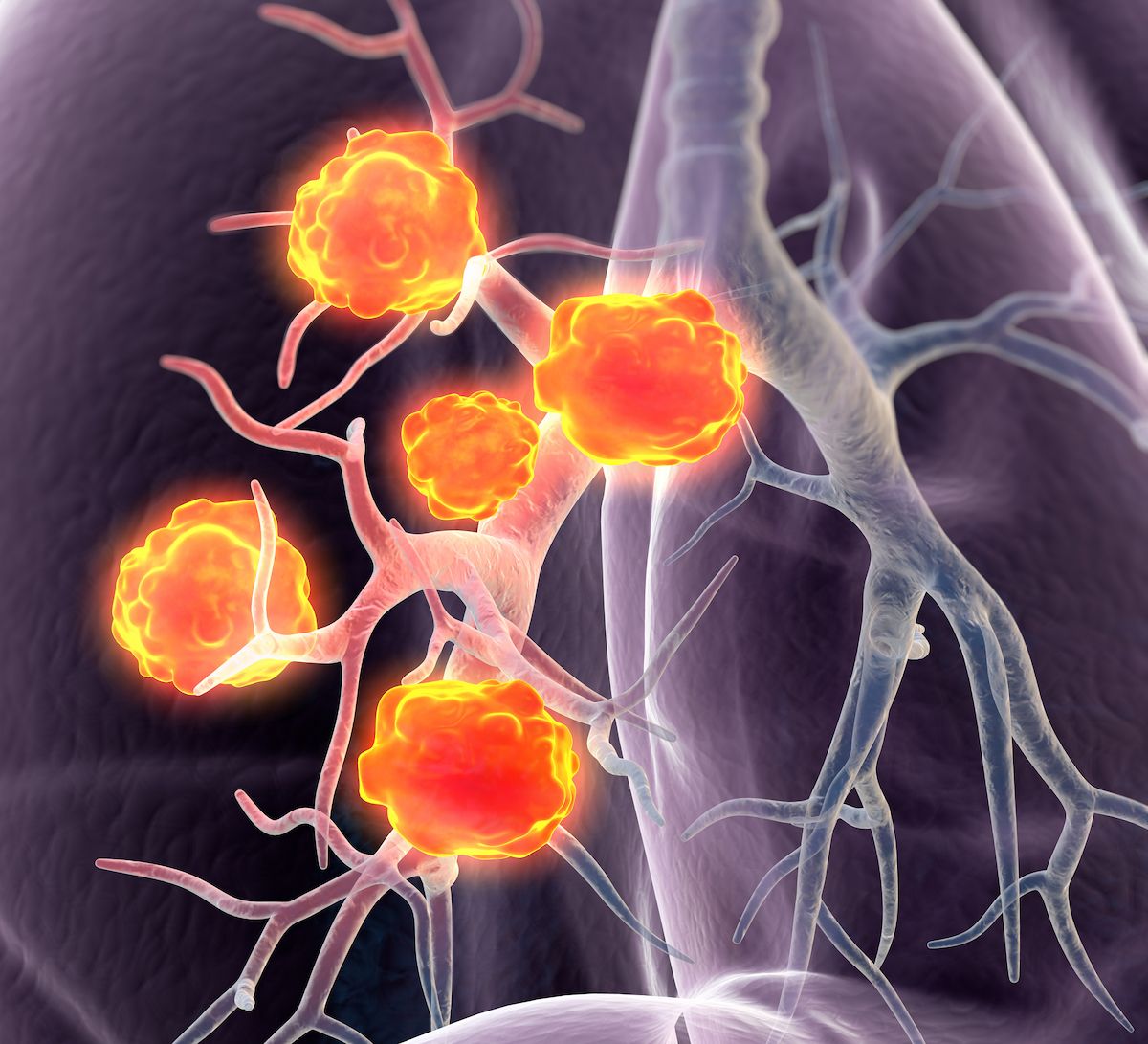Serplulimab Plus Chemotherapy Improves OS and PFS in Older ES-SCLC Populations
The biomarker NLR may not be suitable for prognosis prediction in older patients with small cell lung cancer, according to findings from this real-world study.
The biomarker NLR may not be suitable for prognosis prediction in older patients with small cell lung cancer, according to findings from this real-world study.

Adding serplulimab (Hetronify) to chemotherapy demonstrably improved survival while reducing toxicity in older patient populations with extensive-stage small cell lung cancer (ES-SCLC), according to results from a real-world study published in the Journal of Thoracic Disease.
With a median follow-up of 9.2 months, the median progression-free survival (PFS) was 7.0 months (95% CI, 6.1-12.5), with 6-, 12-, and 18-month PFS rates of 69.4% (95% CI, 56.3%-85.6%), 30.9% (95% CI, 18.3%-52.3%), and 20.6% (95% CI, 9.5%-44.6%), respectively.
Multivariate analysis showed that women had an increased risk of progressive disease vs men (HR, 4.92; 95% CI, 1.11-21.78; P = .04) as well as for those who received brain radiotherapy vs those who did not (HR, 26.16; 95% CI, 3.91-175.00; P < .001). The accelerated failure time (AFT) model showed similar results, with an increase in risk of progressive disease for women (factor, 0.51; 95% CI, 0.29-0.88; P = .02) and those who received brain radiotherapy (factor, 0.25; 95% CI, 0.13-0.47; P < .001).
The median overall survival (OS) was not reached (NR; 95% CI, 12.3-NR), and the 6-, 12-, and 18-month OS rates were 94.7% (95% CI, 87.9%-100.0%), 65.8% (95% CI, 50.0%-86.5%), and 54.2% (95% CI, 37.0%-79.6%).
The univariate analysis showed there was an increased risk of death in patients who were women (HR, 3.64; 95% CI, 1.02-12.96; P = .046), whereas the multivariate analysis showed a significantly reduced risk of death in those with a smoking history (HR, 0.10; 95% CI, 0.01-0.96; P = .046). The risk of death was higher in patients with an ECOG performance status of 1 or 2 (HR, 18.64; 95% CI, 1.29-270.10; P = .03).
The AFT model showed an increased risk of death in patients 75 years or older (factor, 0.34; 95% CI, 0.15-0.75; P = .008) with an ECOG performance status of 1 or 2 (factor, 0.43; 95% CI, 0.25-0.73; P = .002), with receipt of thoracic radiotherapy (factor, 0.41; 95% CI, 0.17-0.96; P = .04), and with brain metastasis (factor, 0.33; 95% CI, 0.13-0.86; P = .02) as well as in those with a smoking history (factor, 1.78; 95% CI, 1.14-2.79; P = .01).
The overall response rate (ORR) was 65.12% (95% CI, 49.07%-78.99%), with 1 complete response and 27 partial responses; the disease control rate (DCR) was 97.67% (95% CI, 87.71%-99.94%), with 14 instances of stable disease.
“Against the backdrop of therapeutic limitations and the historically inferior efficacy and safety of first-line treatment in older patients, this retrospective study yields encouraging findings,” wrote lead study author Meiqi Shi, of the Department of Medical Oncology at Jiangsu Cancer Hospital in Nanjing, China, and coauthors in the paper. “Specifically, the combination of serplulimab with chemotherapy demonstrates survival benefits in [older] patients 70 years and above with ES-SCLC, accompanied by a manageable toxicity profile.”
A total of 43 patients with ES-SCLC were enrolled in 5 centers. Eligible patients were 70 years or older with a histological or cytological diagnosis of ES-SCLC who received first-line treatment with serplulimab. Those with incomplete clinical records were excluded from participation.
The median age of patients was 73 years (range, 70-86), 83.72% were men, 55.81% were never-smokers, 74.42% had an ECOG performance status of 1, and 74.42% had stage IV disease. Further, 27.91% received thoracic radiotherapy and 11.63% received brain radiotherapy.
The primary end point of the trial was PFS. Secondary end points included OS, ORR, DCR, and adverse effects (AEs). The paper also explored the prognostic utility of the neutrophil to lymphocyte ratio (NLR) in older patients with ES-SCLC.
A total of 39 patients included in the analysis had measurable NLR values recorded at baseline and during treatment. The median baseline NLR was 3.09 (range, 1.38-7.27) and was thus used as the threshold defining high and low NLR levels.
Patients with lower baseline NLR levels had a median PFS of 9.2 months (95% CI, 4.57-NR) vs 7.0 months (95% CI, 6.03-NR) in those with higher baseline NLR levels, finding no significant difference (HR, 0.77; 95% CI, 0.35-1.70; P = .52). The difference in median OS was deemed not significant as well (HR, 1.24; 95% CI, 0.40-3.85; P = .72).
After 4 treatment cycles, the NLR value had increased to 4.19 (range, 0.86-20.0; P = .04). When stratifying patients based on their best overall response, posttreatment NLR levels were numerically increased in the ORR group and the non-ORR group, though they were not statistically significant. McNemar paired χ2 test showed no significant difference in NLR levels before and after treatment (P = .18).
Regarding safety, 44.19% of patients (n = 19) experienced any-grade AEs; 32.56% (n = 14) experienced grade 1 to 2 AEs, and 11.63% (n = 5) experienced grade 3 or higher AEs. The most common any-grade AE was anemia (20.93%), elevated serum creatinine level (9.3%), and leukopenia (6.98%). There were no AE-related deaths reported.
“Future well-powered, prospective trials are warranted to provide more robust evidence and refine treatment strategies for this unique and often vulnerable subgroup,” the authors concluded.
Reference
Shi M, Yang W, Zhou Y, et al. First-line serplulimab-based immunochemotherapy in elderly patients with extensive-stage small cell lung cancer: a multicenter, real-world study. J Thorac Dis. 2025;17(5):3157-3169. doi:10.21037/jtd-24-1815